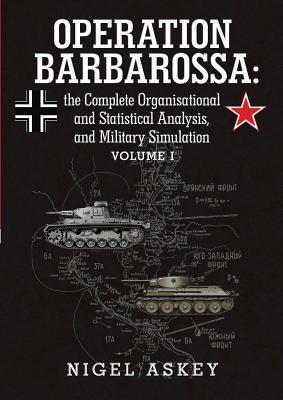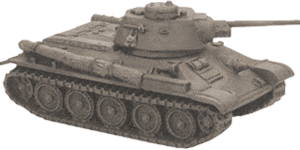Operation Barbarossa

Nigel Askey's Operation Barbarossa Series is nothing short of magnificent. Askey's work will span eight volumes when complete (including a full analysis, tables of organizations and equipment, and orders of battle for both the Axis and the Red Army's forces during Barbarossa). Nonetheless, please note that this review concerns itself only with the introductory volume and both volumes concentrating on the German forces deployed during Barbarossa and within the Reich in 1941. As a military historian whose primary area of research is the 1941-1945 war fought between the Soviet Union and Nazi Germany I do not hesitate to say that I am in awe of what Mr. Askey has accomplished. The level of detail and painstaking work that went into creating these books is nothing short of astounding.
Volume I sets the stage for the rest of the series, but it is by no means required reading for other books in the series. Volume I, however, does have tremdendous cross-over appeal. Not just in and of itself, or to those interested in such topics, but it also offers much to gamers (including me in my few moments of spare time) in advancing Askey's ideas regarding best practices for studying military history via simulations. To that end, it also introduces the reader to the author's Integrated Land and Air Resource Model for the study of not only Barbarossa but other military campaigns. In spite of advancing such goals the author also finds time to pack Volume I with analysis grounded in nearly two decades of study. These observations can be absolutely absorbing not just from a technical but a practical perspective as well that better enables the reader to imagine what soldiers of the Second World War faced in trying to make best use of the equipment they had been provided. For example, when discussing why aircraft mounted weapons struggled to achieve desired lethality in the ground attack role Askey describes how:
Aircraft with unguided weapons were, and still are, relatively inaccurate. By modern standards aircraft in WWII were very inaccurate; particularly against small ground targets the size of a tank...When considered objectively this is not surprising. Against a target protected by light flak or MGs, a WWII fighter-bomber would need to execute a ground attack at speeds above 150 mph (241kmh) to have much chance of survival. This relatively low attack speed still equates to a speed of 67 meters per second. A large Panther tank is only 8.86 meters long (including the barrel) and 3.4 meters wide. This means that if the plane was conducting a strafing attack, the tank would remain in the gun sight for just over a tenth of a second...All of this is before we even consider the tank's motion, the terrain around the tank or the turbulent effects of defending flak. This is not just theoretical. Trials on training grounds in England revealed that fighter bombers attacking with salvoes of up to eight rockets at a time, still only had, at most, a 4% chance of hitting a tank. This was without defending anti-aircraft fire and against a stationary target in an open field. (quote from page 93 of Volume I)
Volume I is chock full of observations such as this, meaning that even though one can skip Volume I and jump into any of the other Volumes I don't hesitate to say that would be making a mistake.
From there Volume II is broken into two parts (Volume IIA and Volume IIB) covering the Organisational and Statistical Analysis of the German armed forces during Operation Barbarossa (the German code-name for their June 1941 invasion of the Soviet Union). Volume IIA continues the fun from Volume I in covering a tremendous amount of ground in terms of familiarizing the reader with pretty much all of the weapons and main equipment used during Barbarossa. Everything is covered here, including how well the weaponry and equipment held up in combat as well as a very welcome look at the practicalities of the equipment's use when deployed. But that is only part of what Volume IIA encapsulates for it also provides the single best set of TO&E (tables of organization and equipment) I have ever seen for the German land combat units deployed in 1941. Laid out in easily readable tables and supported by summaries of each unit one can spend hours here examining the voluminous data gathered. The amount of work that went into this volume alone must have been staggering. Volume IIA, like Volume I, is also filled with ample asides and footnotes where the author's analysis is greatly appreciated as applied to any number of details that even the advanced reader will find unique and interesting.
Volume IIB provides the reader with the order of battle for all German land, air, and naval forces as well as the casualties endured by both sides during Barbarossa. Like Volumes I and IIA there are countless tables helping to organize and make sense of the data. These are the best orders of battle I have ever seen for these units. The level of detail is absolutely absorbing. Every possible unit deployed during Barbarossa is covered in these pages - down to flak companies, bridging columns, and anything else you can dream up. I dare a reader to find a German unit deployed during Barbarossa that is not included here. Perhaps my favorite part of Volume IIB is the entire chapter devoted to the 1941 era German armed forces level of supply distribution and an analysis of German logistical efficiency. To say that this chapter debunks a number of stereotypes regarding the German forces at this point in the war would be an understatement.
I cannot recommend these books enough. Yes, I know they are expensive. But there is a reason for this expense - an enormous investment in time and research went into creating these volumes. Moreover, for anyone with an interest in these topics (or for a researcher) these really are top notch publications with impeccable sources. Lest anyone ask: who is Nigel Askey? I will state that he is a researcher who is as thorough as they come. Moreover, he has a knack for taking complicated subjects and breaking them down in a very well organized and easily readable format. Though not a formally educated historian, he, like myself, has because of the quality of his work been welcomed into the larger community of World War II historians. In addition (and full disclosure), five years ago he published an article for this website on the T-34 in World War II - an article that remains one of the most popular ever published here by an outside researcher (scroll down to the end of the linked article for a further look at his bio and credentials).
Bottom line - for those of you familiar with publications about the German Eastern Front during World War II these books are every bit as indispensable as the work of David Glantz and other such Eastern Front historians widely regarded as the best in the field. I cannot recommend the three volumes that I have read enough, and am looking forward to reviewing the rest of this groundbreaking and highly acclaimed series.



Post new comment